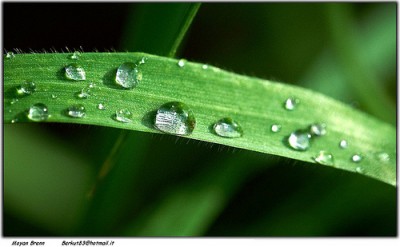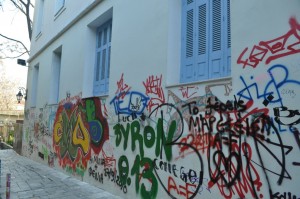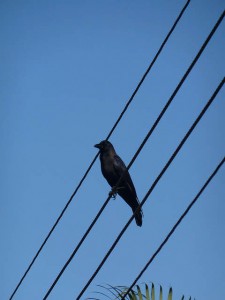by Vani Viswanathan
Reading the entries for this month’s issue, I was faced with oxymoronic feelings: I was happy, as a development practitioner, that so many looked at poverty and at the underprivileged; I was also perturbed that few had chosen to look at some of the wonderful kinds of varieties the streets have to offer. Take, for instance, the variety of colours you’d find on the streets – colours from people, plants, vehicles, animals, things being sold, things being discarded, things being drawn… In this piece, I attempt to capture some of these colours on the streets from my memories across the cities in the world I have lived in or had the fortune to visit.
I remember my tricycle – it wasn’t mine, actually; it first belonged to my cousin who is ten years older, then to my sister, and finally, to me. This tricycle was a deep blue with black polka dots. I have vague memories of riding it around the courtyard of our house, although I don’t know if I actually remember it or it’s something I constructed. My mother however often recollects learning to ride a bicycle before she graduated to a moped; she claims that in that dusty little town we lived in at that point, she used to ride her big BSA SLR, my sister, her BSA Champ, and I, that little tricycle; all three of us riding cycles of varying sizes on a large brown playground. One of my favourite memories on a bicycle would be learning to ride one in the hilly slopes of Borivali, Bombay, on a tiny bicycle rented for an hour for a rupee, with training wheels, and my maternal grandfather jogging along to make sure I don’t fall badly. Eventually, the BSA SLR went to my sister and of course came to me too, and my most daring act on it was to ride past the railway crossing separating T.Nagar and West Mambalam of Chennai, to get to my music classes. No happy memories with this one though: I distinctly remember my tee-shirt getting caught on the seat, and me jerking my head so violently to see what kept me from moving, that I spent nearly a fortnight with the worst sprain of my life, looking at everyone stiff-necked.
I’ve never got the hang of kolam, the South Indian version of Rangoli minus the colour, drawn with powdered rice flour. Beautiful street art. I love watching my mother deftly draw the patterns with a pinch of flour between her three fingers: dots evenly spaced, correctly numbered; lines drawn in one swoosh!, curves drawn so easily as if it were the simplest thing in the world. Voila! Suddenly there are chariots, lotuses, straight lines that just converge into a pattern. For the festivals, there are special kolams: sugarcanes and a pot overflowing with a mixture of rice and milk for Pongal or firecrackers and their funky sparks for Diwali. The most I’ve managed is a six-lined Star of David-like design where each line is of a different thickness, or whenever I’m around, painting outlines with a red mixture using a paint brush around the white lines my mother’s drawn. I wonder if I’ll manage to retain this tradition, though its relevance in these days I know not (apparently it was started as a way to feed birds and insects). I distinctly remember one day of Pongal when I was a child – the day when cows are decorated and their horns painted – when we walked past a temple close to our house and saw a boy drawing a kolam. My mother was surprised, and exclaimed so encouragingly, at which the boy smiled, embarrassed, and ran into the temple with his bowl of rice flour.
I love looking at the walls on the roads when I move from one place to another. As a child growing up in Chennai, there was much to see: movies’ names written in big, block Tamil letters; innumerable ‘P James Magic Show’s followed by a phone number, painted in black; announcements of rallies by political parties, and how could I forget, movie posters, which I think are a dying trend today. Over the last decade, I think I’ve seen quite a lot of ‘cultural’ paintings: temples, wildlife, proud proclamations of the Tamil language, grotesquely shaped Thiruvalluvars, Bharathiyars and other characters from Tamil literature I don’t really know. They do add some colour to the city walls! My favourites though would be the lovely graffiti I have seen on walls in Athens, Greece. They were beautiful! Colourful, whacky, and everywhere – even on trains that travel from one city to another! The centuries-old monuments, however, have been spared. In Singapore, the cleanliness-freak city, obviously, there is nothing unsanctioned on the walls; I remember a ‘Youth Park’ around shopper-haven Orchard Road as one of the few places where graffiti is ‘approved’. Arab Street, with its fabulous restaurants, shops selling carpets and other things of Middle Eastern origin, and some nice bars and sheesha places, has some graffiti too!
Streets during the rains are something few Indians are privileged to be able to ignore. I had my fair share of flooded streets in Chennai that when I went to Singapore and found the streets clean even after hours of torrential rain, I gasped in wonder. All the water went into huge drains alongside each of those wide roads – such meticulous planning that I will always proudly defend the city whenever people call it the crazily organised city. The other thing about Singapore I discovered eventually – at least in my college campus – was that it was possible to walk a fairly long stretch without getting drenched much in the rain. Walkways covered most of the pavements and I used to love walking through the rains, watching, and feeling the drizzle when a particularly heavy wind blew. Of course, Chennai was not as forgiving. I remember wading through one clumsy street, knee-deep in water, my salwar rolled up to no avail, and canvas shoes soaking wet. G.N.Chetty Road, on the way to my school, was particularly nasty during the rains, and I remember looking on with a twang of guilt whenever my father’s scooter stopped mid-way and he would try to kick-start it just so many times. Mumbai, the third city of my life, is just a whole other world when it comes to rains. One particular street that led to my apartment was so full of potholes that it was a nightmare to drive through that stretch in an auto-rickshaw. My friends and I would jostle about in the auto, jumping, wincing, and waiting for that one-minute-turned-three-minute-long stretch to end. The streets would be awash with all kinds of unimaginable and unnameable things; leaves, garbage, dog poo; and even in those rains, I’d carry along my tiny umbrella that would barely cover me, and walk. Shoes would get ruined, umbrellas would be broken, feet would get unbelievably dirty and would need vigorous scrubbing with Dettol, but I’d still insist on walking back often. During the rains, nonetheless, the streets take on hues that are just out of the world. Greens are greener, the tar of the roads drenched and darker, little drops drip off leaves, unfortunate flowers – tiny yellow ones my favourite – get washed into the many streams running the roads.
Vani Viswanathan is often lost in her world of books and A R Rahman, churning out lines in her head or humming a song. Her world is one of frivolity, optimism, quietude and general chilled-ness, where there is always place for outbursts of laughter, bouts of silence, chocolate, ice cream and lots of books and endless iTunes playlists from all over the world. Vani was a Public Relations consultant in Singapore and decided to come back to homeland after seven years away to pursue a Masters in Development Studies. Vani blogs at http://chennaigalwrites.blogspot.com







